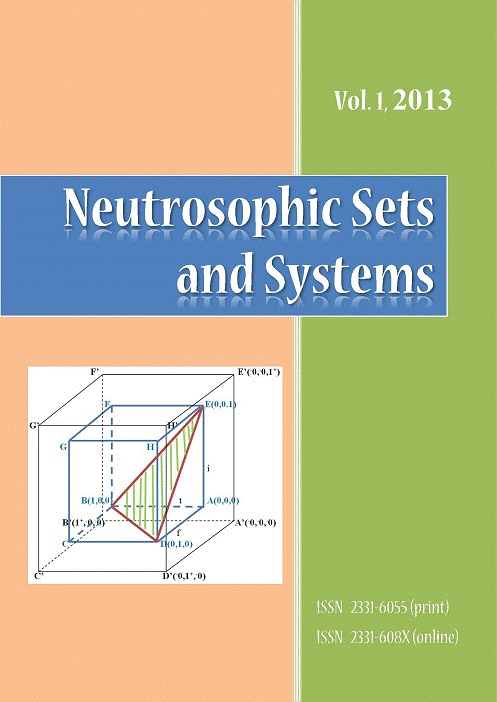Neutrosophic Sets and Systems
Volume 26 (2019)
Article
Neutrosophic Triplet Group (revisited)
Florentin Smarandache and Mumtaz Ali
Neutrosophic model to measure the impact of management projects on the process of pedagogical-research training
Katia Lisset Fernández Rodríguez, Graciela Abad Peña, M. Tamara Ortiz Luzuriaga, and Y. Ramos López
Neutrosophic statistics applied to the analysis of socially responsible participation in the community
Johana Cristina Sierra Morán, Jenny Fernanda Enríquez Chuga, Wilmer Medardo Arias Collaguazo, and Carlos Wilman Maldonado Gudiño
Neutrosophic statistics methods applied to demonstrate the extra-contractual liability of the state from the Administrative Organic Code
Paúl Alejandro Centeno Maldonado, Yusmany Puertas Martinez, Gabriela Stephanie Escobar Valverde, and Juan Danilo Inca Erazo
Validation of the proof reversal on the inexistence of untimely dismissal by using neutrosophic IADOV technique
Wilson Alfredo Cacpata Calle, Antonella Stefanía Gil Betancourt, Nicole Jazmín Enríquez Guanga, and Katherine Trinidad Castillo Núñez
Compensatory fuzzy logic model for impact assessment when implementing ICT in pedagogical scenarios
P.Yajaira Jadán Solís, B. Aracely Auria Burgos, M. Lilian Triana Palma, and C. Yohanna Mackencie Álvarez
Neutrosophic model for the analysis of criminal behaviour in Quevedo, Ecuador, from a spatial econometric analysis
P. Milagros Moreno Arvelo, J. Carlos Arandia Zambrano, G. Karolina Robles Zambrano, and J. Emperatriz Coronel Piloso
Neutrosophic model to determine the degree of comprehension of higher education students in Ecuador
Jesús Estupiñan Ricardo, María Elena Llumiguano Poma, Alexandra Maribel Arguello Pazmiño, and Andrea Daniela Albán Navarro
Pestel based on neutrosophic cognitive maps to characterize the factors that influence the consolidation of the neo constitutionalism in Ecuador
Manuel Antonio Calderón Ramírez, Julio César de Jesús Arrias Añez, Orlando Iván Ronquillo Riera, and Raúl Gilberto Herráez Quezada
Softcomputing in neutrosophic linguistic modeling for the treatment of uncertainty in information retrieval
D. Vitalio Ponce Ruiz, J. Carlos Albarracín Matute, E. José Jalón Arias, and L. Orlando Albarracín Zambrano
Use of neutrosophy for the detection of operational risk in corporate financial management for administrative excellence
Lyzbeth Kruscthalia Álvarez Gómez, Danilo Augusto Viteri Intriago, Aída Margarita Izquierdo Morán, and Luis Rodolfo Manosalvas Gómez
Cased-based reasoning and neutrosophic logic to identify the employment limitations for Law school graduates at UNIANDES Ibarra
Diego Chamorro Valencia, Teresa de Jesús Molina Gutiérrez, Lenin Horacio Burbano Garcia, and Alipio Absalón Cadena Posso
A Model of neutrosophic recommendation for the improvement of the consents of the ICSID arbitration procedure in Bolivia, Ecuador and Venezuela
Carlos G. Grimaldo Lorente, Víctor Hugo Lucero, Marco Chulde, and Jaime Cadena.
Neutrosophic model based on the ideal distance to measure the strengthening of values in the students of Puyo university
Mauricio Amat Abreu and Dunia Cruz Velázquez
Pestel analysis based on neutrosophic cognitive maps and neutrosophic numbers for the sinos river basin management
R. González Ortega, M.David Oviedo Rodríguez, M.Leyva Vázquez, and J. Estupiñán Ricardo
Prospective analysis of public management scenarios modeled by the Fuzzy Delphi method
N. Batista Hernandez, M. Bernarda Ruilova Cueva, B. Narcisa Mazacón, and K. de Mora L.
Use of the Iadov method to measure the implementation of a program for sexual abuse prevention in Ecuador
Sara Ximena Guerrón and Yadira Narciza Almeida Montenegro
Neutrosophic model for the analysis of the causes that lead to tax fraud
Paúl Alejandro Centeno Maldonado, Brandon Paul Adriano Caiza, Cristian Salomón Yuqui Vilacrés, and Fernanda Margarita Guerra Alomía
Neutrosofic Iadov for the analysis of satisfaction on the regularities in the international legal field concerning the human rights of migrant workers in Ecuador
Mercedes Navarro Cejas, Magda Cejas Martínez, Luis Fernando Piñas Piñas, and Janneth Ximena Iglesias Quintana
Neutrosophic model for the analysis of administrative offences on sexual abuse in the ecuadorian educational system
Klever Anibal Guaman Chacha, Eduardo Hernández Ramos, Cesar Ochoa Dias, and Telmo Salomón Coba Toledo
Use of neutrosophy for the analysis of the social reintegration factors of released prisoners in Ecuador
Leny Cecilia Campaña Muñoz, Holman Steven Sánchez Ramos, and Johanna Rocío Cabrera Granda
Use of Neutrosophy to analyze problems related to the joint custody of children and adolescents after marriage dissolution
Alipio Absalón Cadena Posso, Carlos Javier Lizcano Chapeta, Miguel Leonardo Sola Iñiguez, and Alex Fernando Gómez Gordillo
Use of Neutrosophy to recommend conceptions related to the integral protection of the right to life
Janneth Ximena Iglesias Quintana, Milton Jiménez Montenegro, Mesías Elias Machado Maliza, and Ximena Cangas Oña
Use of the neutrosophic IADOV technique to diagnose the real state of citizen participation and social control exercised by young people in Ecuador
Alexandra Andino Herrera, Maritza Cuenca Díaz, Hayk Paronyan, and Viviana Murillo
Neutrosofic statistics applied to demonstrate the importance of humanistic and higher education components in students of legal careers
Rogelio Meléndez Carballido, Hayk Paronyan, Marvelio Alfaro Matos, and Alberto Leonel Santillán Molina
Full Issue
Full Issue
Neutrosophic Sets and Systems



